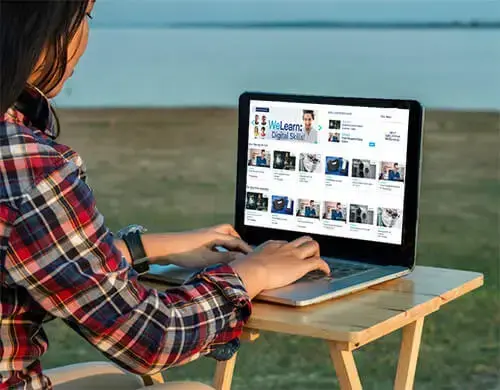Planning and implementing a technology-based learning landscape is a challenging project. Manufacturers of various learning platforms advertise that their products to make learning motivating, fulfilling and efficient. Is it possible for a learning platform to support organizational target and learners' individual aims at the same time?
To start with let us assume, that "learning technologies" and "(e)learning" are often used as rather vague meta-denominations, subsuming a whole bandwidth of various formats and functionalities. To create motivational and sustainable learning processes within organizations just takes more than implementing any learning platform. Enterprises aim for intentional learning processes, targeted to enhance business value. To achieve this well-designed blended learning concepts are an essential part. To succeed, the individual learning- and motivational structure must be considered, as well as the organizations culture, the maturity level of learning and digitalization of the organization, not to mention the respective business strategy.
Thus, not only the various elements of learning technology and their effects must be understood, but also the general conditions of successful corporate learning. Only then, a technology-based learning landscape can be implemented and operated successfully.

Differentiate clearly between the individual parts of a learning landscape. Learning Systems often entail similar functionalities but differ widely concerning flexibility and expansion of supported processes.
To decide how to put your learning landscape on a higher level of productivity you must understand learning processes as well as the meaning of qualifications and competencies for your organization. Their status effects the organizational culture, the learning and transfer motivation of learning and transition.
Short Glossary of Learning Technology
Learning Platforms offer direct or indirect access to learning content. A learning platform enables a learner to quickly find relevant information. These might be eLearnings (WBTs, pdf, tests), video tutorials, text-based information but also classroom courses, seminars or training programs containing one or more learning formats (blended learning). To discover the appropriate elements a logical structure, search functionality and filter options are a must.
A learning platform may be accessible for everybody by using the internet. Competitive academies might publish their offer online, but access is usually limited by a registration or payment process.
Learning Portals differentiate between various target groups. For certain job-profile or management levels only particular content might be relevant. Learning portals entail not only different content for own staff and external sales partners, technical staff or customers, but will also support different processes concerning approval, booking, invoicing and more. Learning portals can also provide access to certain functionalities for authorized persons only, for example a manager checking the qualification status of his/her team, enrollment or her/his team members, reporting on different issues...
A Learning Management System (LMS) administrates the total of learning content assignment and publishing, workflow definition. It includes features like rights and role definition, reporting, automated correspondence and the efficient coordination of training equipment. (Also read: What is an LMS?)
An important quality criterion is the possibility to adjust to new (future) developments and processes, without being completely dependent on the LMS supplier. Also the Learning System must be integrated in the overall system landscape via interfaces exchange data with other systems, such as HR, finance etc.
Learning is an intrapersonal process - always!
Learning portals, Learning platform, LXP or LMS are infrastructural elements, employed to support individual learning by offering secure access to learning content and formats.
Sustainable learning, going beyond the intake of information, is due to a combination of content, reflection, exchange and application.
Learning content is created by employing authoring tools of all kinds. Depending on the learning target and learner various media (video tutorials, WBTs, presentation, virtual / augmented reality ...) is suitable to transform information or knowledge in didactically logical learning units. These learning units can be accessed via the learning platform or may be integrated in classroom courses, webinars, training programs etc.
Authoring tools used to produce learning media (e.g. tutorials, tests), but are no integral part of the LMS. However LMS and learning platform must be able to integrate all sorts of products of various authoring tools and make them available to the appropriate learners.
Consider Learning Targets carefully
Learning targets differentiate, whether they change behavioral pattern to a more or less extreme extend or focus solely on the intake of information. In consequence to the desired outcome, you may want to select different media and learning formats. This differentiation determines also based on economic considerations, what learning formats and media are appropriate.
Bloom's taxonomy gives you a better impression what learning outcomes you might want to address (table according to: Bloom, 1976, S. 200f):
Taxonomy Level
Learning Outcomes
Performance
Knowledge
Recall facts and information on command
enumerate, dublicate, identify, label, list, match, define, , describe, memorize ...
Comprehension
explaining, summarizing and interpretation of factual information
classify, cite, describe, report, paraphrase, restate, review, select, summarize ...
Application
Apply in new context / in new situation
calculate, reason, proof
Analysis
Decomposing something in their components to be examined, understood and reconstructed.
construct, control, demonstrate, implement, illustrate, relate, project, participate, assess, compute ...
Evaluation
Judging on fact based information, personal values or definite criteria, determine if something is suitable for its purpose
reflect, appraise, decide, conclude, estimate, judge, choose, reframe, predict, support, value, validate ...
Synthesis
Creative development of new knowledge, develop ideas further, create new combinations;
adapt, anticipate, compose, generate, hypothesize, model, manage, organize, reinforce, formulate ...
This results in the question, which media, and formats (or which combinations) might be most appropriate to achieve learning success in the best possible way. For example: learning nuggets and eLearning address the levels knowledge and comprehension. They are suitable for preparing future, more complex content, or the achievement of a formal qualification.
Higher taxonomy levels continually focus competencies. The European competence frame defines competencies as "abilities to create new situations self-organized". This is only to be achieved in a longer time frame and sustainable learning arrangements. Prerequisite is to build up learning and reflection competencies.
⇒ The technological, content, and cultural elements of the learning landscape are to be designed in a way, to enable sustainable learning on an individual and collective level.
Sustainable, motivating learning processes
To achieve corporate learning goals, you must consider what makes learning processes successful learning processes and how to influence the outcome. There are many theories and models about learning, which offer different explanations:
- Piaget's theory of cognitive development denies that humans not just adjust to stimulate of their environment like stated in behaviourism, but construct their individual world view step by step to make sense of new impulses. New experience is compared with existing categories of understanding. If no category is seen to be suitable a new category is created.
- Lev Vygotzky stresses that social interaction is fundamental to cognitive developments. A higher level (next zone of cognitive development) of skills, understanding and learning can be achieved in dialogue and common reflection of learning progress with others with various (but not too different) degrees of knowledge and experience.
- Kolb's model of learning states an ever recurring cycle of reflection of experiences, consisting of the stages:
- Concrete Experience (emotion)
- Reflective Observation (realization)
- Abstract Conceptualization (reflection)
- Active Experimentation (acting)
- Illeris describes learning as an interactive process between individual and environment within a field of tension („learning triangle"). These dimensions offer levers to influence learning outcome.
- Siebert identifies ten characteristics of sustainable, motivating learning processes. These may be used as clues to reflect on cultural, didactic and technological circumstances of the learning environment and how learning technology can improve them.
Characteristics of sustainable, motivating learning processes:
- Connectivity
- Novelty
- Relevance
- Emotion
- Situatedness
- Physicality
- Networking
- Aestheticization
- Perturbation
- Coevolution
(Siebert, 2006, S. 90-91)
- Connectivity: Good learning concepts have a strong connection to the previous understanding, knowledge, tasks and (jon) situation of the learner. „Adult learn sustainably, when they can work on their own challenges.“ (Schüßler; Thurnes, 2005). LMS can support connectivity by refering to the eductation history of the learner, job and qualification profile and compare those with data of peers, carreer paths and typical task profiles. Personal (learning) recommendations of managers, coaches and peers complete the picture. Finally, the learner should also decide himself, what is relevant for him and witch formats and contents advance his situation.
- Novelty: Neuronal processing of information does only happen if it contains novelty to some degree. Combined with "connectivity" this bears an element of flow-equilibrium. How much "new" does stimulate the learner to appreciate it in connection to previous skills and knowledge.
- Relevance and situatedness: Learning content is judged by its potential value in job-related, daily and future tasks. Evolution theories state, that learning processes focusing on factual action and life relevance are seen as being more motivating than abstract, theoretical information. A "learning just in case" with no connection to a realistic use case has a subordinate status. Both aspects focus on the learnign content not on format or media. It has a strong influence on the learner's motivation.
- Emotion: Motivation is based on feelings of approach tendencies (instead of tendencies of avoidance). Is the central motivation of learning the reception of a confirmation of attendance or the passing of a test, this is seen as a defensive approach. Is learning considered as a chance to acquire new knowledge, new skills and experiences to advance the personal situation (career, successful project ...) it is considered as expansive learning. Thus, emotion connects to learning taxonomies. Higher levels of the learning taxonomy hierarchy (competencies) are based on an emotional connection - the learning subject "moves" the learner. Mere knowledge is not a competency but part and basis of it (see. Arnold/Erpenbeck (2021).
- Physicality: Learning is a mental but also a physical activity. Our receptivity is directly connected to physical phenomenon such as tension and relaxation (Damasio, 2004, S. 227 ff). This aspect is related to our physical and cultural learning environment. You might want to reflect on the communication patterns in your organization concerning informal discussion, information exchange in a more formal formats such as e. g. Communities of Practice, seminars ...) or communication media (virtual classrooms, webinars, chats…).
- Networking: supporting subconscious brain activities, cognitive and emotional connection of neuronal networks by appropriate didactic/methodical concepts. You may want to employ didactical design concepts such as e. G. ADDIE, Ganges or Mayers 15 principles of Multimedia Learning (Mayer, 2021) for conducive design of learning content. Bear in mind that a part of efficient learning (meaning the creation of new connections by new impressions and information) is the active un-learning of outdated information.
- Aestheticization: It is an obvious necessity to support the connection of different channles of perceptions with stimulation visualization and possibly multimedia design of learning content (also Mayer, 2021). The design on the learning platform is to be aesthetic, but many functional and logical. Quick detection and access to suitable formats and content is the center of reliable process support.
- Perturbation: Targeted triggering of cognitive dissonances as well as the enablement of controlled difference experiences („surprises“) can enhance motivation, as new stimuli cause new interpretations and perceptions. Depending on the personality of the learner and the strength of the impulse, perturbation may also cause frustration, overload and aggression resulting in defensive behavior. This is especially the case when the experience can not be reflected in a constructive surrounding e. g. with peers, trainers, management.
- Coevolution: Development and learning happens by reconstruction of individual realities. Learning progress can be intensified by exchange and reflection formats within groups. Again: for successful integration of social and collaborative formats the organizations culture and communication style is essential, no matter if personal synchronous (webinars, seminars ...) or asynchronous formats (fora, comments ...) are concerned.
Conclusion: Consider the impact design and didactics of learning contents may have on the various characteristics to encourage successful and motivating corporate learning processes. Think critically how your organizational communication- and learning culture contributes (positively or negatively) to achieving your qualification goals.
Learning in Phases: Acquisition and Application
Targeted learning processes consist of two phases: the acquisition and application (performance) phase, which mutually influence each other. In consequence one should differentiate between learning motivation and transition. Many an institution or corporation offer learning subjects such as "learning to learn" or offer learning support. Both formats focusing on the „intake“ (acquisition process). These organizations obviously focus on competencies, especially learning competencies compared to pure qualification projects.
During the acquisition phase the focus is on extending knowledge, skills and new concepts, whilst the performance phase focuses on transfer. Depending on the learning goal the performance phase is to transfer the recently acquired information productively on actual job-tasks. This transfer is not to be mistaken with evaluation of training satisfaction, which does not refer to learning success. Also, mere tests are to be doubted when it comes to a apply learnings to real life situations.
Unsatisfying performance can be due to multiple causes, which might not be the result of an inadequate learning phase. Reasons might be found in an intrapersonal condition or banal realities, such as an inappropriate furnishing with tools and appliances of the workplace. Also, the attitude of the working environment towards innovations is essential for successful application. Clue: If the general attitude of manager, department or organization towards learning is merely defensive and learning not seen as a chance you might want to consider measures.
Academies and staff development of organizations often focus mainly on the acquisition phase, delivering highly elaborate and excellent services. But often the learners are left to their own devices during application. This might impact future motivation and practical experience negatively. If learning support ends with the passing of a test, this is often interpreted as a successful learning achievement. Seeing learning as a private matter between personnel development and employee, especially if it takes place outside the normal workplace, might make the achievement of transfer goals (higher productivity, more efficient solution of problems ...) impossible. Efforts and investments of the acquisition phase might result in a mere nothing.
To make sure corporate learning is worth it, you might also want to focus on the application phase. This expectation is especially directed to managers in their role as enablers and peers as reflection partners, consequently to be anchored on an organizational (cultural) level. Also, self-efficacy and motivation are levers to learning success.
Learning Motivation is not static
Motivation research is a vast field. Often motives are clustered in classes describing what drives people. Often classes such as power, performance and social motives (Mc-Clelland, 1961) or desire to create, joy of capability or meaningfulness (Pink, 2009) are examined. Motivation is always multi-dimensional and connected to the emotion of a person. This also applies to learning motivation.
Siebert defines learning motivation as a combination of values, triggers, structural characteristics, and activities (Siebert, 2006, S. 146). Considering motivation under these aspects, illustrates that motivation cannot be static, but subject to certain influences over time. Thus, you are not only to consider the initial motivation of the learner, but also how and why this might change during the learning process.
The development of learning motivation is decisively influential on the learning result, which consequently effects the performance after the training. At the end in corporate learning the aim is not the learning process in which to acquire skills and knowledge, but the successful application (wanting to apply, be able to apply, be allowed and encouraged to apply) and therefore an intentional action.

The Rubicon model describes four chronological phases of intentional motivational actions. It differentiates between the evaluation of the goal (initial motivation), planning, doing and the estimation of the value of the learning outcome. Motivation to reach a goal may in consequence vary during both the learning acquisition and the learning application phase.
This can result in different conscious and subconscious decisions. If the learning goal is continually worth the effort during the learning processes and the possibility of achievement seen as realistic, targeted action (learning) is consequently continued (assimilation).
Even with high initial motivation learning content turn out to be too complex or not sufficiently useful. The achievement of the learning goal might be seen as unachievable, or the learning goal turns out to be less desirable than anticipated. In this case it is likely that the effort to achieve the goal and complete the training will be adjusted accordingly (accommodation). The focus may change from the desire of perfectly commandment of a new skill to a "just-to-pass-the test" attitude.
Within an enterprise the status of successful learning processes must be seen in relation to the investment, which is necessary to offer the exact support required by the learner not only during the acquisition but also during the application phase. From the organizational view you are to consider what type of service is appropriate to increase the likelihood that certain learning goals will be reached and contribute to your enterprise’s success.

References to suitable technological support will not be found within the otherwise detailed and differentiated list of models and transfer methods from Lemke (Lemke,1995) or Hebein (Hebein, 2016). However modern (digital) learning environments for acquisition or performance are an essential part of corporate learning.
Synchronous exchange formats such as lunch & learn, communities of practice can take place in real-life as well as in virtual surrounding. Learning platforms and the internet offer information (learning nuggets, glossaries, fora, blogs ...) any time anywhere (but be aware that media competency is relevant to judge, what is a genuine information). Collaboration and communication tools are part of any enterprise learning structure. Countless tools and formats support digital knowledge management (Mittelmann, 2019) and can be integrated in flexibly designed digital learning landscapes.
⇒ Conclusion: Appropriate learning technology during the acquisition and application phase can offer targeted support for learning processes and motivation. But learning technology is not the sole decisive factor for motivated, sustainable learning processes.
Consequences for Learning Technology
To apply the previous information to learning technology stresses, that learning platforms are just carrier media. Their job is to provide the learner quickly with suitable learning content. Various content is to be accessible directly (video tutorials, WBTs, pdf, online tests ...) or indirectly via an enrollment (courses, training programs, coaching, webinars ...), independent from formats or certain authoring tools. This requires dynamic functions and filter criteria for an active search or pre-configured individual settings to directly assign learning content.
Learners might be provided with mandatory learning assignments or optional recommendations from their management or select courses due to the recommendations or rating of peers. If a system is to recommend learning content, it requires detailed information about the learners preferences, job profiles, career options. This requires a thorough data collection and maintenance by the organization or the learner by himself. Also, AI-based recommendations are referring to these information. In addition to information from a data base an AI-based system might track browser data, search terms and click pattern and interpret this in not always transparent algorithms (which might be trial and error for some time, as it requires lots of data for an appropriate outcome). This might not always correspond to data protection guidelines or ethic guidelines for trustworty IT.
Core requirement for learning technology is the capability of supporting individual, versatile learning processes, independent from format, tools and didactical concept.
Sustainable learning processes require a thorough conception and well thought out combination of relevant content, formats in an appropriate surrounding, independent if the latter is technology based digital or analogue. To ensure that this will not result in a selective, isolated intervention you will want to employ Blended Learning Concepts featuring flexible and versatile learning arrangement.
Modern blended learning is more than a arbitrarily interplay of various formats, including virtual or life social learning offers. Blended Learning entails the possibility of individual flexibility, putting the learner first. To visualize a complex and connected learning arrangement a learning platform should in any case include a Curriculum Editor. This tool illustrates the connections and dependencies of different learning units, displays detail information of each part and offers options to the learner where possible.
A holistic learning landscape therefore is to include various aspects, formats and media and makes them available to the individual learner, if possible, without media disruption.
 Blended Learning in a Training Program
Blended Learning in a Training Program
Successful Blended Learning Concepts:
- Definition of target dimensions and methods to evaluate anticipated learning progress and result.
- Conception: Connection of learning goals with adequate content, format and media (learn arrangements) under consideration of their impact concerning sustainable and motivation learning processes.
- Individual, flexible and optional support of learners during the whole motivation cycle in the acquisition and application phase.
- Sustainability by integration of reflection and exchange formats (personal, virtual...), as well as following learning impulses.
Conclusion, Tipps, Todos
It is no secret, that successful enterprises adjust to dynamically changing markets. They have understood, that they have to enter into the demands of their customers (batch size 1). Clearly competitive organizations can not risk to take a complete other position in times of skills shortage.
► Check if and how intensely personal learning support is granted to employees consequently depends on the organization's status of individual learning success and development. It illustrates a certain organizational culture if staff is expected to be anytime willing and able to perform, to learn self-motivated and profit solely from self-organized training
Issues:
- How do decisions effect the mentioned features (Siebert, 2006)?
- What learning targets are in focus?
- How helpful is the current organizational and learning culture?
- How can learning technology support individual learning processes within the acquisition and application period?
► Once the status of learning in general is clear, it is to be analyzed how intentional learning within the organization will be sustainable, flexible and future proof.
► Then evaluate, which elements favor sustainable learning processes and how these can be promoted. Consider technological, didactic, content and cultural elements of your enterprise from this point of view.
► Accompany your learners along their learning path, including their application period to analyze motivation cycles. Pay also special interest to inhibiting elements during the application and performance period.
► It is mandatory to differentiate between the various levels and possibilities of learning technology, be it learning platform, learning portals, Learning Management System oder elearning.
Only then learning technology can take your corporate learning to a higher level, increase productivity and staff satisfaction.

About SoftDeCC
Since 1998 SoftDeCC is working closely with major training centers and academies. This results in a unique experience with training requirements.
Our Learning Management System is designed to adjust to individual corporate learning processes and address evolving challenges. More...

Contact us
We are looking forward to sharing our experience with you.
Call +49 (0)89 / 3090 839 30 to discuss your corporate learning challenge.
Learn more:
Quality Criteria for Learning Management Systems
Integration of Learning Architecture
QuickCheck: Is TCmanager® LMS the right tool for your purpose?
Sources:
Arnold, R.; Erpenbeck J. (2021). Wissen ist keine Kompetenz. Dialoge zur Kompetenzreifung. Hohengehren: Schneider Verlag GmbH.
Bak, P. M. (2019). Lernen, Motivation und Emotion. Berlin: Springer.
Bloom, B. S. (1976). Taxonomie von Lernzielen im kognitiven Bereich. Weinheim, Basel: Beltz.
Damasio, A. R. (2004). Descartes' Irrtum: Fühlen, Denken und das menschliche Gehirn. Berlin: List.
Hebein, E. (2016). Lerntransfersicherung in der betrieblichen Weiterbildung. Saarbrücken: Akademiker Verlag.
Illeris, K. (2006). Das "Lerndreieck". Rahmenkonzept für ein übergreifendes Verständnis vom menschlichen Lernen. In E. Nuissl, Vom Lernen zum Lehren. Lern- und Lehrforschung für die Weiterbildung (DIE-Spezial) (S. 29-41). Bielefeld: Bertelsmann.
Lemke, S. (1995). Transfermanagement. Göttingen: Hogrefe.
Mayer, R. E. (2021). Multmedia Learning. Cambridge: Cambridge University Press.
McClelland, D. (1961). The achieving society. Princeton: Van Nostrand.
Mittelmann, A. (2019). Wissensmanagement wird digital. Norderstedt: BoD Books on Demand.
Pink, D. H. (2009). Drive. Edinburgh: Canongate Books Ltd.
Schüßler, I; Thurnes, C. (2005). Lernkulturen in der Weiterbildung. Bielefeld: W. Bertelsmann Verlag GmbH & CO. KG
Siebert, H. (2006). Lernmotivation und Bildungsbereitschaft. W. Biertelsmann Verlag GmbH & Co. KG.





